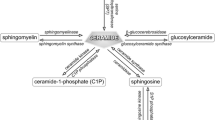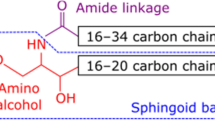Summary
Psoriasis is marked by loss of glycocalyx. Glycocalyx is composed of glycoproteins and glycolipids such as cerebrosides. It was shown that the incorporation of 14C-linoleic acid in cerebrosides of normal and psoriatic human skin is different. In psoriatic epidermis and corium the turnover of this fatty acid is significantly elevated. It is suggested that in psoriasis the epidermal cell is not able to build up a regular carbohydrate sequences of lipids because the false carbohydrate chain activates the degradation of glycolipids and in compensating for the increased degradation raises the synthese rate of glycolipids.
Zusammenfassung
Die Psoriasis ist durch eine starke Verminderung der Glykokalyx gekennzeichnet. Die Glykokalyx wird aus den Kohlenhydratketten der Glykoproteine und Glykolipiden gebildet. Wir bestimmten den Einbau von 14C-Linolsäure in die Cerebroside normaler und psoriatischer menschlicher Haut und stellten fest, daß der “turn-over” dieser Fettsäure in den Cerebrosiden psoriatischer Epidermis und psoriatischen Coriums signifikant erhöht ist. Diese Befunde interpretieren wir als Unfähigkeit der psoriatischen Haut, die vollständigen Kohlenhydratketten in regulärer Sequenz für die Cerebroside zu synthetisieren. Die irregulären und/oder unvollständigen Kohlenhydratketten aktivieren den Abbau dieser Cerebroside, was im Sinne einer Kompensation zur erhöhten Synthese und damit zum erhöhten “turnover” der Fettsäure von Cerebrosiden führt, deren Halbwertzeit gegenüber normaler Haut verkürzt ist.
Similar content being viewed by others
References
Burton K (1956) A study of the conditions and mechanism of the diphenylamine reaction for the colorimetrie estimation of deoxyribonucleic acid. Biochem J 62:315–321
Cooper MG, McGrath H, Shuster S (1976) Epidermal lipid metabolism in psoriasis and lichen simplex. Br J Dermatol 94:369–378
Evers U, Kunze D, Egger E (1974) Bestimmung der sauren und neutralen Glykolipide in autoptischem Material. Z Med Labortechnik 15:202–204
Mahrle G, Orfanos CE (1977) The plasma unit membrane. Membrane mediated growth control and its failure in psoriasis. Br J Dermatol 96:215–223
Mercer EH, Maibach HI (1968) Intercellular adhesion and surface coats of epidermal cells in psoriasis. J Invest Dermatol 51:215–221
Orfanos CE (1971) Scanning electron microscopy in psoriasis. In: Farber EM, Cox AJ (ed) Psoriasis. Proceedings of the International Symposium. Stanford Univ 1971. Univ Press, Stanford, Calif, pp 169–185
Orfanos CE, Schaumburg-Lever G, Mahrle G, Lever WF (1973) Alterations of cell surfaces as a pathogenetic factor in psoriasis. Possible loss of contact inhibition of growth. Arch Dermatol 107:38–46
Orfanos CE, Mahrle G (1975) Membrandefekt als Basis der gestörten Wachstumsregulation bei Psoriasis. Dermatologica 151:199–215
Rüstow S, Metz D, Kunze D, Meffert H (1980) 14C-Linolsäureeinbau in die Lipide normaler und psoriatischer Haut. Dermatol Monatsschr 166:96–101
Voorhees JJ, Duell EA, Stawiski M, Harrell ER (1974) Cyclic nucleotide metabolism in normal and proliferating epidermis. In: Greengard P, Robinson GA (ed) Advances in cyclic nucleotide research, vol 4, Raven Press, New York, pp 117–162
Watson W, Cann HM, Farber EM, Nall ML (1972) The genetics of psoriasis. Arch Dermatol 105:197–207
Weinstein GD, Frost P (1971) Methotrexate for psoriasis: A new therapeutic schedule. Arch Dermatol 103:33–38
Author information
Authors and Affiliations
Rights and permissions
About this article
Cite this article
Rüstow, B., Metz, D., Kunze, D. et al. Incorporation of 14C-linoleic acid in cerebrosides of psoriatic and normal human skin. Arch Dermatol Res 270, 441–444 (1981). https://doi.org/10.1007/BF00403788
Received:
Issue Date:
DOI: https://doi.org/10.1007/BF00403788




